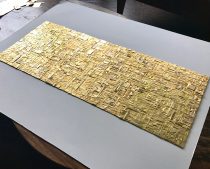first published in Juxtapoz, September 2013
GRAPHITE & GOLD
The Art of Gianluca Franzese
by Matt Gonzalez
Italian-born, San Francisco based Gianluca Franzese has worked for three years as Andrew Schoultz’s primary studio assistant. Classically trained in drawing at the Florence Academy of Fine Arts, his own work focuses on utilizing an acrylic dry brush technique, with added gold leaf elements, to render geometric patterns found in nature. He has previously documented buildings in San Francisco’s Presidio, which once stood as a military outpost, as well as other historic buildings including the iconic, columned, former police station on 17th Street in the Mission District. Consistent in his work is a kind of trompe l’oeil: what looks like graphic work in his practice, pencil and graphite on paper, is actually acrylic black paint on white surface. Franzese belongs in the tradition of process painters who invest as much time preparing canvas as producing a composition. The medium is unforgiving. Painting with acrylic on a scrupulously prepared white paper surface doesn’t leave room for error. One mistake and he’s resigned to starting over. Therein lies the crux of the endeavor, risking everything in pursuit of an artwork which is obscured from all but the most discerning viewer.
After one year at Pratt, Franzese transferred to the Florence Academy of Art in Italy focusing on Old Master techniques, his female nudes and still lifes of that era recalling the style of Caravaggio. He was drawn to methods of depicting natural light in a three-dimensional drawing.
After a successful career selling these realistic paintings, done under a pseudonym, Franzese adopted a contemporary style. Associated with many of the artists around Guerrero Gallery where he has his own studio, Franzese has embraced modern techniques of composition and process. Well-known Bay Area artist Andrew Schoultz, whose own show at the Monterey Museum of Art runs through November 17, has greatly influenced the direction Franzese’s work has taken.
Franzese spends hours preparing to make a picture. When he works with paper, he uses multiple coats of PVA (or rabbit-skin glue) to help the paper maintain integrity so that it doesn’t over-absorb the paint medium. In the case of gold leaf, which Franzese often utilizes, PVA assists in adhering the metallic leaf to the surface without it being absorbed into the paper (or in some cases, wood).
Black and white landscapes and portraits are drawn onto either white Stonehenge paper or a gessoed panel with pencil, then painted in with black latex paint. Copper, gold, bronze, or silver leaf is then applied over areas and sometimes manipulated with fire, chemical or distress for certain effects.
The final surface is the product of many layers. In particular, the leafing is applied to the painting after the design is traced from a separate drawing and transferred to the main work. Each of these steps is deliberative and imbued with his Old Master training, setting his method apart from those contemporary artists who lack his ability to draw realistically and who work directly on a surface without any preparation. His goal is to make a composition that pops and stands up–in effect, to create three-dimensionality.
With the works that render geometric patterns, Franzese carefully paints images with insects calculated to fit dimensions like a puzzle. He draws from different palates of colors, then gold, white gold, silver, bronze, or copper are applied to fit into sections of a geometric shape. Once the geometric backdrop is laid out, insects are painted on to create the desired three-dimensional effect that plays with the viewer’s perspective.
Fifteen years ago he began working with oil, adding mastic varnish to make the natural color richer. In the last two years, after other experimentation, he has moved to acrylic, utilizing a fine 9 brush for this dry brush technique. What started as a way to obtain the effect of etching and printmaking, particularly the shading, led Franzese to began painting with a flat latex black on white surfaces to approximate the look and feel of aquatint or graphite on paper. Eschewing the use of white, Franzese relies on the paper color to contrast with the black paint. The resulting painting resembles ink on paper, like an engraving technique, an aquatint. But it’s not graphite — it’s all acrylic.
In addition to rendering patterns and creatures that inhabit nature, such as snakes, ants, and bees, Franzese has also tackled local architecture before it is renovated or otherwise disappears. A building such as the historic Mission Police Station becomes a subject, in part, because of the evanescence of the lifespan. Franzese captures that presence while he can, and although ostensibly run-down, conveys its majesty.
Consumed by geometric shapes that are often grid-ridden, Franzese is intrigued by how pictures change with the slightest alteration or manipulation of an angle. Perspective and focal point shift with the slightest adjustment, just as a mathematical equation changes the moment a single number is varied.
Franzese inherently walks the high wire, inexorably attracted to a process that, at various moments if duped by a slipping hand, can render weeks of toil useless. Like a fresco painter who works with fresh plaster, once the pigment is absorbed it can only be fixed by starting anew.
His father, a jeweler, instilled an adherence and application to the smallest detail, which in turn nurtured equilibrium, proportionality, and vision for the primacy of geometric shapes. Today, a Franzese canvas embodies that craftsman’s precision.









